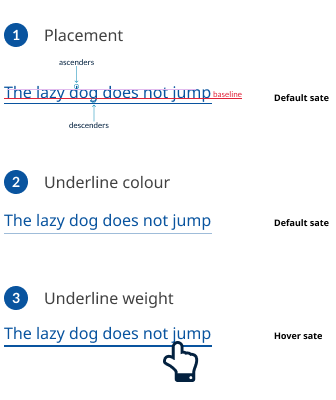Design
Anatomy
Below is a breakdown of the 3 main components of our underline anatomy which are placement, colour and thickness.

- Placement
Our underlines are placed 1px below the descenders of words. To ensure this scales proportionally to the text size we aim to define the offset value. This is set a sit wide variable that can be adjusted if different fonts are used.
- Colour
The following 4 colours are defined by the user to control the colour of underlines across different background colours. These colours define the default colour of the underline on the rest state. On hover the underline colour changes to the link text colour.
Light underline#3F7AB4
Light visited#8B63B0
Dark underline#B5CCE2
Dark visited#E1C2FF
- Underline weight
On hover the underline stays in same position, but the thickness increases and colour changes to the link text colour. The underline weight is defined by 2 variables. The rest state is 0.5px and the hover weight is 2px. Not all devices support half px values so on lower resolution devices the underline will display as 1px weight by default.
Research and rationale
To ensure that this design has a rock-solid foundation, the design process followed a problem-oriented rather than a solution-oriented approach. We approached this component design with the desire to have a solid and broad understanding of the requirements and challenges facing users of Queensland Government websites with varying levels of cognitive, literacy and visual ability. The end goal was to create an inclusive solution that improves the user experience for all users.
Researching the needs and challenges facing users with cognitive and visual difficulties followed Human Centred Design and Design Thinking principles. With this approach we were able to better understand the challenges experienced by different user groups, and could also uncover the root causes to these challenges. By understanding the root causes of each challenge we were able to confidently tailor a solution that addresses each challenge. These designs also meet WCAG AA compliance.
Underline to close to text
The underline is too close/overlaps text and visually looks like part of the word. It's harder to skim or read through blocks of content with underlines.
About this problem
Using “text-decoration: underline” the underline is very close to the baseline of text and overlaps letters with descenders, changing the overall shape of the word. For people who have difficulties with reading, this can make reading text which is underlined harder, and may result in misreading words and misunderstanding text.
How has this been addressed
The underline is moved 1px below text descenders to not obstruct any characters of a hyperlinked word. This is achieved by using the border-bottom and padding-bottom properties.
It's also recommended to follow the content writing style guides and avoid using too many hyperlinks within body copy.
Considering the needs of vision impaired users
About this problem
The solution must use familiar UI patterns and be accessible for users who are vision impaired (low vision, colour blind) or users who have low contrast screens/using a device in the sun. If the underline is to be removed the solution must meet 1.4.1: Use of Color (A).
How has this been addressed
The underline hasn't been removed from hyperlinks. The underline also meets accessibility requirements and has a minimum contrast of 4:5.1 to the background colour. On hover the underline increases in weight rather than changing colour which enables colour blind users to see the transition.
Rules were also created for how to present hyperlinks to ensure that expected, familiar and consistent UI patterns are used and WCAG requirements met.
Underlines make content or page layouts look busy
About this problem
Aesthetically when viewing a block of paragraph text, underlined hyperlinks create unbroken solid horizontal lines throughout the content, which can distract from reading the content.
How has this been addressed
The line thickness and colour of the underline is reduced so that visually the strength of the underline isn't the same as the rest of the text.
Progressive enhancement
Progressive enhancement in this design applies to the weight of the underline at a hyperlink's default state. Pixels in CSS are an abstract unit of measure and vary depending on the resolution of devices. On high resolution devices, a single CSS pixel may be displayed across 2 pixels. A fractional pixel will round up to the nearest whole number. This means that higher resolution devices can display thinner lines.
On lower resolution devices the underline will display as 1px weight. Higher resolution devices will display the underline at 0.5px, using a half width allowed us to continue to comply with 1.4.1 Use of Color (A) and 1.4.3 Contrast (Minimum) (AA) and present a more aesthetic and clean design.